Rancher Prime in Azure: Usage Instructions
Prerequisites
- A Rancher-compatible AKS cluster. Please see Rancher support matrix for more details. The Rancher Prime PAYG offering can only be installed onto clusters in regions where both the Azure Kubernetes service and Azure Container Apps service are available, see the Azure documentation for details. Please see Creating an AKS cluster for bringing up an AKS cluster to install Rancher Prime PAYG which is covered in the later section of this document.
- An ingress installed on the AKS cluster so that Rancher is accessible outside of the cluster. Please refer to Rancher documentation for instructions on how to deploy Ingress-INGINX on AKS cluster.
- The Rancher hostname must be a fully qualified domain name (FQDN) and its corresponding IP address must be resolvable from a public DNS. Please refer to Rancher documentation for instructions on how to setup DNS.
How to install Rancher Prime PAYG
The following is a step by step walk-through for creating a new deployment of Rancher Prime from the Azure Marketplace page.
- Click "Rancher Prime with 24x7 Support" offer (either "EU and UK only" or "non-EU and non-UK only") that corresponds to the location where your account is registered.
- Choose the plan from the dropdown list. ( "Plans + Pricing" tab more details about Software plan)
- Click 'Create'
Basics
- Select an existing subscription from the dropdown list.
- Select an existing Resource group from the dropdown list.
- Select an existing AKS Cluster Name from the dropdown list.
Choose a name for the Cluster extension resource. The name must be between 2 and 253 characters in length and contain only alphanumeric characters and dots.
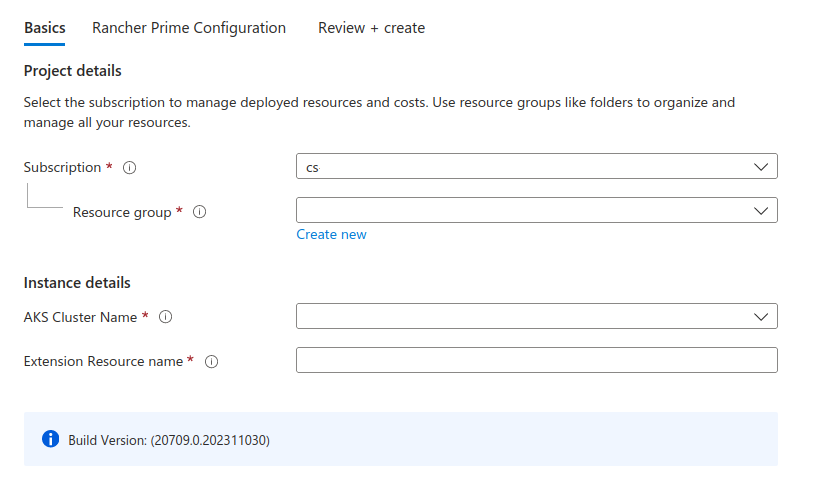
NOTE
The Create new resource group feature is not supported.
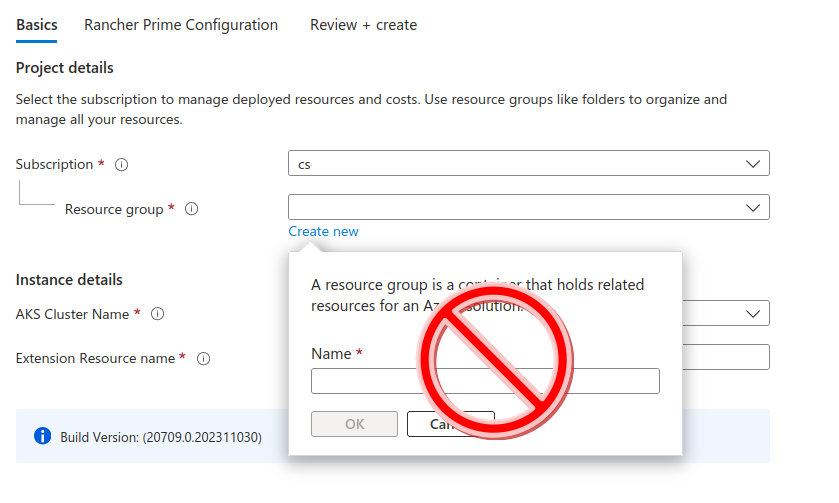
click 'Next'
Rancher Configuration
Enter the hostname for Rancher, and it must be a fully qualified domain name (FQDN). The Rancher server URL will be created using this hostname.
NOTE
The IP address of the Rancher hostname must be resolvable by a public DNS.
Using the slide bar, select the number of Rancher replicas.
Choose bootstrap password as it is suggested by the tip. The bootstrap password will be used to authenticate to the Rancher dashboard during first login.
NOTE
The current Rancher deployment exposes the bootstrap password in the Cluster configuration settings in Azure Portal. Until this is resolved, it is suggested to change the Admin password after the initial login. Edit profile in the Rancher dashboard to change password.
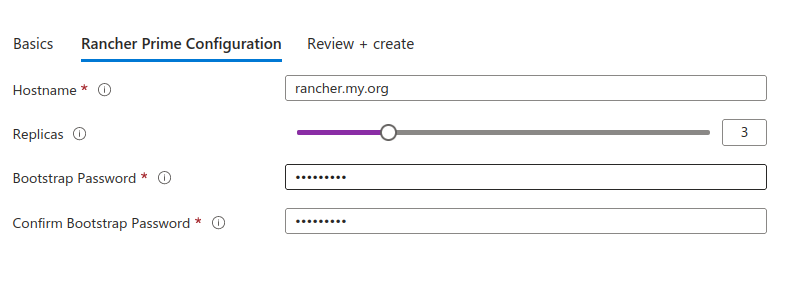
click 'Next'
Review + create
This will summarize the offer and link to "view automation template" (Azure Resource Manager Template)
Price
Basics
Rancher Configuration
click 'Create'
Deployment Complete
Deployment will be in progress. After it is completed, the Rancher Prime Kubernetes service extension is successfully installed.
NOTE:
In the "Extensions + applications" page, the "Provisioning State" may show "Succeeded" even though the provision may still be in progress. You may monitor the actual progragress by logging into the AKS cluster and follow the "rancher-cloud" deployment.
Log into the Rancher dashboard
You may now login to Rancher dashboard by point your browser to Rancher server URL https://<Rancher hostname>, where Rancher hostname is the hostname you have chosen previously.
NOTE
The Rancher hostname must be resolvable by public DNS. Please refer to the Prerequisites section for more details.
How To Use Rancher
Please refer to the Rancher documentation on how to use Rancher.
After logging into Rancher Prime, you should notice the Welcome to Rancher Prime message at the top of the screen.
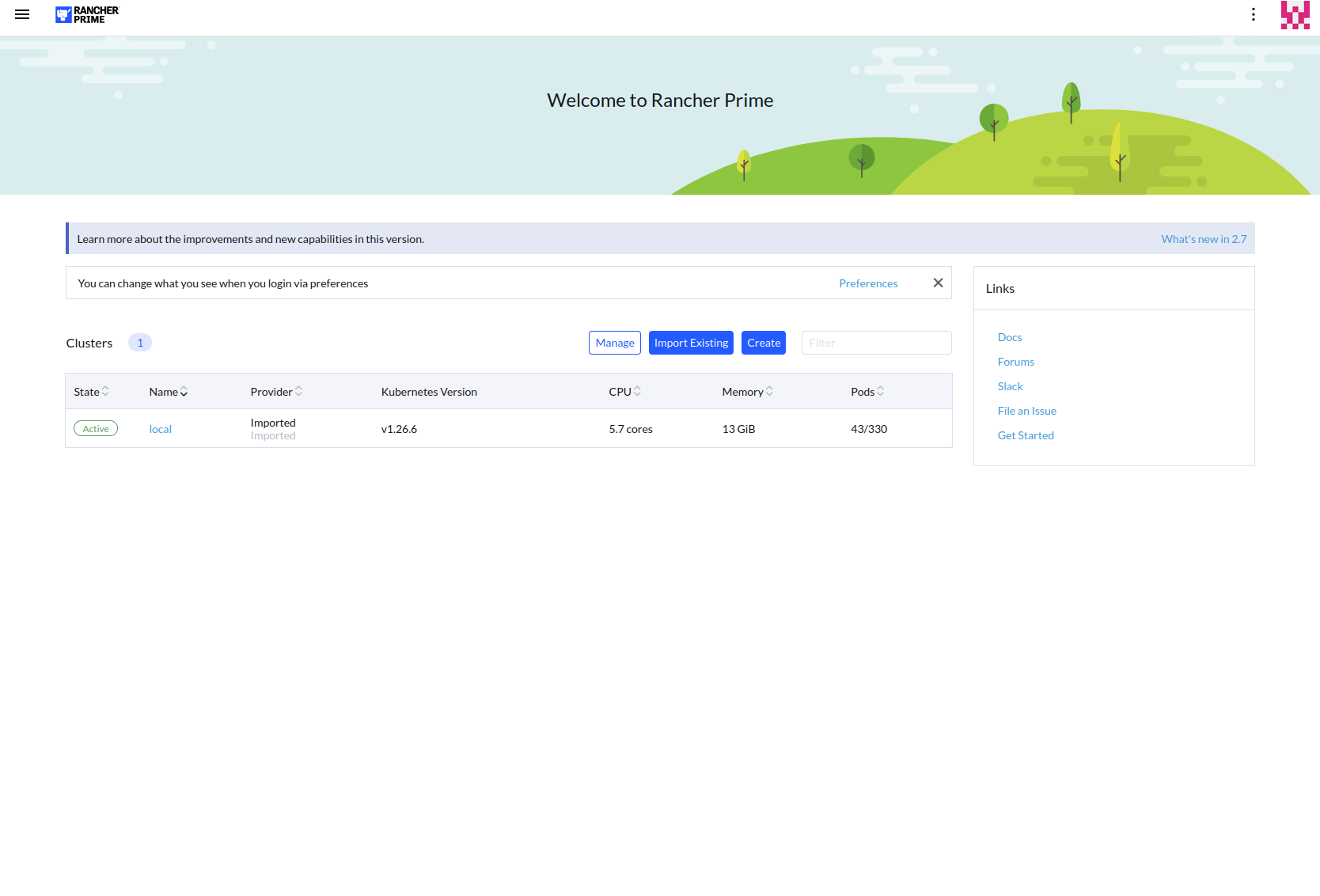
If your Rancher Prime PAYG deployment only has Welcome to Rancher at the top of the screen, please ensure you've updated to the latest version, and reset the branding to default (i.e. "suse") from Global Settings.
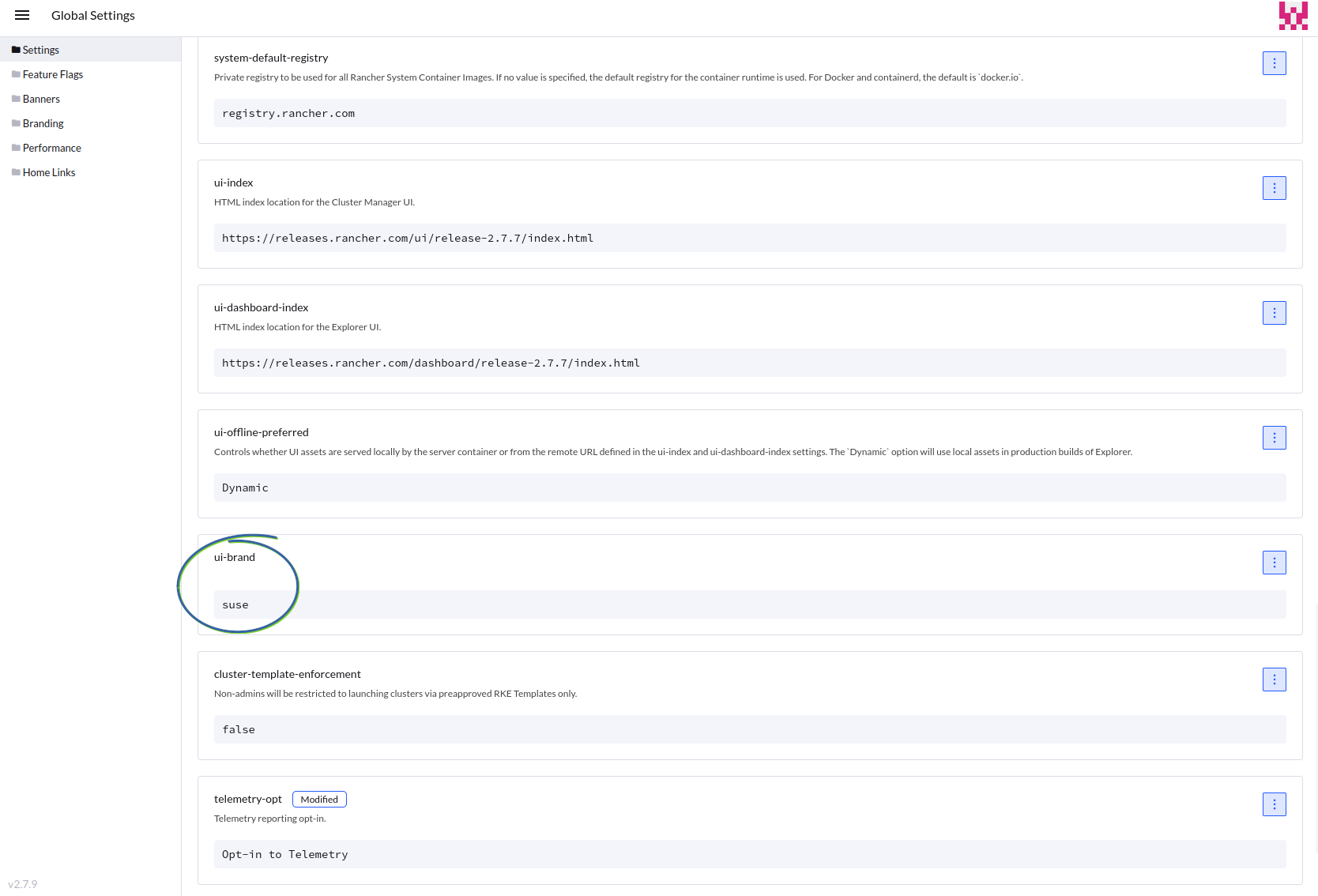
Rancher Prime PAYG billing
Billing will be available in the Azure Portal billing
Home > Cost Management <subscription> | Cost analysis
Upgrading a Rancher Prime PAYG Cluster
The Azure marketplace PAYG offer is periodically updated as a new version of Rancher Prime are released, and for optimizations in the integration with Azure. To update the latest version of the Rancher Prime PAYG offering supported in the marketplace listing, use the "az k8s-extension update" command.
Execute the following command in Cluster Cloud Shell:
az k8s-extension update --name <cluster extension resource name> --cluster-name <cluster name> --resource-group <resource group> --cluster-type managedClusters --version <version to be upgraded>
Troubleshooting
This section contains information to help you troubleshoot issues when install Rancher and configure Billing-adapter
After successful deployment, it should list similar pod and chart output
kubectl get deployments --all-namespaces=true
NAMESPACE NAME READY UP-TO-DATE AVAILABLE AGE
cattle-csp-billing-adapter-system csp-rancher-usage-operator 1/1 1 1 8h
cattle-csp-billing-adapter-system rancher-csp-billing-adapter 1/1 1 1 8h
cattle-fleet-local-system fleet-agent 1/1 1 1 8h
cattle-fleet-system fleet-controller 1/1 1 1 8h
cattle-fleet-system gitjob 1/1 1 1 8h
cattle-provisioning-capi-system capi-controller-manager 1/1 1 1 8h
cattle-system rancher 3/3 3 3 8h
cattle-system rancher-webhook 1/1 1 1 8h
cert-manager cert-manager 1/1 1 1 8h
cert-manager cert-manager-cainjector 1/1 1 1 8h
cert-manager cert-manager-webhook 1/1 1 1 8h
ingress-nginx ingress-nginx-controller 1/1 1 1 9h
kube-system coredns 2/2 2 2 20h
kube-system coredns-autoscaler 1/1 1 1 20h
kube-system extension-agent 1/1 1 1 8h
kube-system extension-operator 1/1 1 1 8h
kube-system konnectivity-agent 2/2 2 2 20h
kube-system metrics-server 2/2 2 2 20h
Jobs and Pods:
Check that pods or jobs have status Running/Completed
kubectl get pods --all-namespaces
if a pod is not in Running state, you can dig into the root cause by running:
Describe pod
kubectl describe pod <pod name> -n <namespaces>
Pod container logs
kubectl logs <pod name> -n <namespaces>
Describe job
kubectl describe job <job name> -n <namespaces>
Logs from the containers of pods of the job
kubectl logs -l job-name=<job name> -n <namespaces>
Rancher Usage Record Not found:
Error:
Error from server (NotFound): cspadapterusagerecords.susecloud.net "rancher-usage-record" not found"
Check Configuration, Retrieve generated configuration csp-config
Solution:
kubectl get cm -n cattle-csp-billing-adapter-system csp-config -o yaml
if a configuration is not listed, you can dig into the root cause by checking the pod status and log (Refer Jobs and Pods section).
Multiple extensions of same type:
Error:
Multiple extensions of same type is not allowed at this scope. (Code: ValidationFailed)"
Solution:
AKS cluster already has the extension with the same type. Uninstall the extension and re-deploy with the same cluster.
Resource already existing in your cluster:
Error:
Helm installation failed : Resource already existing in your cluster : Recommendation Manually delete the resource(s) that currently exist in your cluster and try installation again. To delete these resources run the following commands: kubectl delete <resource type> -n <resource namespace> <resource name> : InnerError [rendered manifests contain a resource that already exists. Unable to continue with install: ServiceAccount "rancher" in namespace "cattle-system" exists and cannot be imported into the current release: invalid ownership metadata; annotation validation error: key "meta.helm.sh/release-name" must equal "test-nv2-reinstall": current value is "testnv2-plan"]
Solution:
AKS cluster already has the extension. Uninstall the extension as it suggested in the Error by deleting the resource via the kubectl command. or Uninstall the extension in Azure Console and re-deploy with the same cluster.
Support configuration does not display the rancher product information or the upgraded product version
Once the rancher-cloud components are installed, the support configuration takes approximately an hour to show the product information. In an upgrade scenario, the support config might still have base_product field reference to the pre-upgrade version but after the next usage update (approximately in an hour), the support config should reflect the upgraded version.
Known Issues
When migrating Rancher to a different AKS cluster by following the steps specified in Rancher Backups and Disaster Recovery, Rancher Prime must be reinstalled via the Azure marketplace on the target AKS cluster after restoring from the backup. Furthermore, the restored Rancher version must not be newer than the version available in the Azure marketplace.
Uninstalling Rancher Prime may not cleanly remove all the resources that were created by Rancher. Users are encouraged to use Rancher cleanup script to perform a more comprehensive cleanup if necessary. However, it is recommended to migrate any other workloads off the cluster and prepare to destroy the cluster to complete the uninstallation since cleanup is not recoverable.